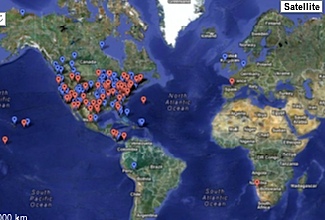| Field Stations and Marine Laboratories of the Future: A New Strategic Vision |
| Monday, March 18, 2013 12:00 AM |
|
Field stations and marine labs join forces to tackle national environmental challenges
A world threatened by extreme weather, invasive species, emerging disease and increasing uncertainty needs the scientific capacity to face those challenges. Natural laboratories around the country, which have been placing researchers on the front lines of understanding and managing environmental change for a century, form the building blocks of that capacity. Today the Organization of Biological Field Stations and The National Association of Marine Laboratories release a report showing how scientists in communities across the continent respond to emerging questions in flexible and nimble ways, and are poised to work together to contribute to global solutions.
Field stations and marine labs (FSMLs) are the primary places scientists go to study environmental processes in their natural context, and as such they harbor the knowledge of the past that we need to predict the future. They host thousands of individual researchers at hundreds of locations, and are the birthplace of many of the innovations and discoveries that drive environmental science today. Recent large-scale initiatives, such as the National Ecological Observatory Network (NEON) and the Ocean Observatories Initiative (OOI), as well as the longer-running Long-Term Ecological Research (LTER) network, depend on existing FSML infrastructure—and the novel insights these new observatories generate will stimulate complementary research at many more field stations and marine labs.
However, only a small fraction of FSMLs participates in these broader-scale scientific initiatives. NEON and LTER represent 10% of the available long-term, place-based, multiple-investigator environmental research sites. The report Field Stations and Marine Laboratories of the Future: A Strategic Vision
 , based on a national workshop and survey and on input from the broader scientific community, recommends creating a Network Center to catalyze broader-scale science and to facilitate participation in coordinated environmental efforts. For example, a stronger network of FSMLs could contribute to evolving national and international programs such as the sustained National Climate Assessment or the Group on Earth Observations Biodiversity Observation Network. , based on a national workshop and survey and on input from the broader scientific community, recommends creating a Network Center to catalyze broader-scale science and to facilitate participation in coordinated environmental efforts. For example, a stronger network of FSMLs could contribute to evolving national and international programs such as the sustained National Climate Assessment or the Group on Earth Observations Biodiversity Observation Network.
Field stations and marine labs have the flexibility and the logistical and intellectual capacity to support novel experimental approaches across tremendous ecological diversity. Collectively, they represent billions of dollars of investment in research infrastructure including sites (forests, fields and waterfronts) and tools (sensors, ships and cyberinfrastructure), and have trained generations of environmental scientists.
This report is a first step in making sure the nation's investment in field stations and marine labs continues to meet the dynamic and changing needs of scientists, students, and the public they serve.
CONTACT: Ian Billick, 970-349-6669, [email protected]
The National Association of Marine Laboratories (NAML), organized in the late 1980's, is a nonprofit organization of over 120 members employing more than 10,000 scientists, engineers, and professionals and representing marine and Great Lakes laboratories stretching from Guam to Bermuda and Alaska to Puerto Rico. The member institutions of the National Association of Marine Labs work together to improve the quality and effectiveness of ocean, coastal and Great Lakes research, education and outreach. Through these unique national and regional networks, NAML encourages ecosystem-based management, wise local land management and the understanding and protection of natural resources.
The Organization of Biological Field Stations (OBFS) is a 501(c)(3) nonprofit that represents field stations throughout the world. The mission of OBFS is to help member stations increase their effectiveness in supporting critical research, education, and outreach programs. OBFS pursues this goal in a manner that maximizes diversity, inclusiveness, sustainability, and transparency.
|

